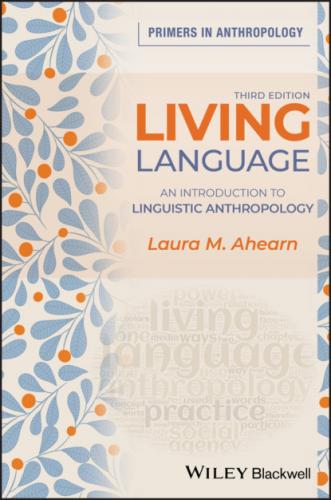List of Figures
1.1 Cartoon demonstrating how certain styles of speech can both reflect and shape social identities.
1.2 Khim Prasad (left) during the Pounded Rice Ritual, with the bride, Indrani Kumari (seated at the right, completely covered by a shawl), and the bridal attendant (standing in the center).
1.3 “Zits” cartoon about the varying cultural meanings associated with language use.
1.4 Jakobson’s model of the multifunctionality of language.
1.5 Cartoon playing off the language ideology that considers French a romantic language.
1.6 Semiosis as a relation between relations.
2.1 A gesture with many possible meanings: “Peace,” “V for victory,” or “Turn around, I want to kiss you”.
4.1 The cultural concepts of hed and save in Gapun, Papua New Guinea.
5.1 Relationship between language and thought according to the (mistaken) “strong” version of the Sapir–Whorf Hypothesis.
5.2 Scene from 2016 film Arrival. Picture credit: Paramount Pictures.
5.3 Relationship among language, thought, and culture according to contemporary understandings of the Sapir–Whorf Hypothesis within linguistic anthropology.
5.4 Cartoon ridiculing the tendency of some scholars (especially those without any training in linguistics or anthropology) to make tendentious claims about the effects of a lack of a specific word in a given language.
5.5 Another of the many representations in popular culture of the “Eskimo words for snow” myth.
5.6 Set-up for experiment involving coordinate systems.
6.1 Strong, multiplex, high-density network with individual “X” at center.
6.2 Weak, uniplex, low-density network with individual “X” at center.
6.3 Peter Auer’s continuum of codeswitching, language mixing, and fused lects.
7.1 Nepali love letter (with all identifying features removed).
7.2 Cartoon showing how certain linguistic forms, such as be + like, can index social identities.
9.1 Spatial configuration at August 1990 Tij songfest in Junigau (X = woman, Y = man).
10.1 Cartoon referring to author Deborah Tannen’s ability to understand gendered language. Tannen writes about the communication between men and women.
12.1 Ten most commonly spoken languages in the world in 2020 (including those spoken as second languages).
12.2 Top four most commonly spoken native or second languages in the world in 2020 (including those spoken as second languages).
12.3 Cartoon depicting normal and inevitable changes in a language over time.
13.1 Doxa as that which is taken for granted and therefore outside the universe of discourse.
List of Tables
1.1 English pronouns in the nominative case
1.2 Nepali pronouns in the Junigau dialect
5.1 Metaphors that a research organization in New Zealand, The Workshop, encouraged people to avoid and embrace during the COVID-19 pandemic
7.1 “Be + like” as a percentage of total quotatives in face-to-face and IM talk (2003 face-to-face n = 248; 2003 IM n = 35; 2006 face-to-face n = 468; 2006 IM n = 175; table created from data reported in Jones and Schieffelin 2009:88)“Be + like” as a percentage of total quotatives in face-to-face and IM talk (2003 face-to-face n = 248; 2003 IM n = 35; 2006 face-to-face n = 468; 2006 IM n = 175; table created from data reported in Jones and Schieffelin 2009:88)
10.1 Findings of Hyde’s meta-analyses regarding gender differences in communicative behavior
Preface
Language, especially as it is used in real-life social contexts, can be absolutely fascinating but rather challenging to study. Linguistic anthropology as a discipline offers a set of concepts and tools for undertaking this challenge. My goal in this book is to provide an accessible introduction to the main principles and approaches of linguistic anthropology without overly simplifying the complex contributions of scholars in the field. To the degree that this book succeeds in accomplishing this goal, it will be useful not just to graduate and undergraduate students studying linguistic anthropology for the first time (to whom I very much hope to communicate my enthusiasm for the field) but also to all sorts of other readers who might, for various reasons, be interested in “living language.” These readers might include, for example, cultural anthropologists, practicing anthropologists, sociologists, or political scientists who have never looked closely at language in their work but could benefit from doing so. I also hope the book will be of value to linguists whose work thus far has been more technical and abstract in nature but who would like to turn their attention to the study of actual instances of linguistic practice. And finally, I hope the book will appeal to anyone who has a natural curiosity about the central role language plays in shaping and reflecting cultural norms and social interactions.
Within the United States,
